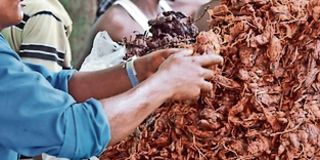Versatile tamarind will give you food, timber and medicine

Traders sell tamarind pulp in Mombasa. Tamarind trees produce edible fruit pulp which is used for souring porridge, juices, fried seeds, seasoning and flavouring. PHOTO | FILE | NATION MEDIA GROUP
What you need to know:
- According to Kenya Forestry Research Institute’s (Kefri) Guide to Planting Trees in Kenya, it grows in ecological zones whose altitude ranges from 0 to 1,500m above sea level.
- Because it can survive in semi-arid lands, it has a big potential to increase Kenya’s farm forestry cover.
- It also produces food (edible fruit pulp, which is also used for souring porridge, juices, fried seeds, seasoning and flavouring).
- The seeds are a rich source of protein and have a favourable amino acid composition.
Tamarind (Tamarindus indica), or ukwaju in Kiswahili, is native to Africa but is adapted to a wide geographical distribution in semi-arid tropics. It grows in India, Southeast Asia, South America, Australia and North America.
According to Kenya Forestry Research Institute’s (Kefri) Guide to Planting Trees in Kenya, it grows in ecological zones whose altitude ranges from 0 to 1,500m above sea level. Annual rainfalls range from less than 400mm to more than 1,400mm.
Because it can survive in semi-arid lands, it has a big potential to increase Kenya’s farm forestry cover.
Tamarind can reach a height of 25 metres and live for more than 300 years. In Kenya, it grows in semi-arid regions such as Garissa, Tana River, Lamu, Kitui, Machakos, Makueni, Taita-Taveta and Kajiado.
This tree provides firewood, charcoal, timber, poles and posts. Its wood can be easily carved into furniture, utensils (pestles and mortars) and boats.
It also produces food (edible fruit pulp, which is also used for souring porridge, juices, fried seeds, seasoning and flavouring).
Its leaves, twigs, bark and roots provide medicine and fodder while flowers are good for bee forage and, therefore, honey production. The tree also produces mulch and fixes nitrogen in the soil.
Tamarind fruits are used for fresh consumption and for the preparation of juices, sauces, jams, beverages and syrups. In South East Asia, its pulp is used in preparation of many cuisines and curry recipes.
The seeds are a rich source of protein and have a favourable amino acid composition.
Medicine
Various parts of the Tamarind tree are used in the preparation of medicine. Roots: In West Africa, according to the Handbook of African Medicinal Plants, Iwu M, M (CRC PressConsumer), the roots are used for leprosy treatment. They are also the principal ingredient in remedies for cardiac diseases.
Leaves: Tamarind leaves and flowers, dried or boiled, are used in treating swollen joints, sprains and boils. Lotions and extracts made from them are used as antiseptics and for treatment of dysentery, jaundice and skin infections.
Bark: The bark of the tree is an ingredient in medicine given as a remedy for indigestion, colic, asthma and eye inflammation.
Seeds: The powdered seeds are made into a paste for treating boils and are prescribed for chronic diarrhoea and dysentery.
This is according to Improving Rural Livelihoods through Domestication of Indigenous Fruit Trees in the Parklands of the Sahel by Kalinganire, A.; Weber, J.C.; Uwamariya, A. and Kone, B., published by the World Agroforestry Centre.
Propagation
Tamarind is propagated by seeds, grafting, cuttings and air layering. Unlike many other trees whose seeds have to be planted in a maximum of three months, Tamarind seeds are viable for up to two years.
They cost Sh2,000 per kilogramme at Kefri seed shops and require pre-sowing preparation. This involves soaking in warm water overnight. This speeds up germination which occurs within one or two week after sowing.
Plants grown from seeds start producing fruits in about six years. Those grown from cuttings or seedlings from nurseries take a shorter time.
Good mother trees are chosen for vegetative propagation. For commercial growers, the spacing should be a minimum of five metres, but this can be up to 15 metres if it is mixed with other crops. Because of its nitrogen-fixation properties, it is good with most crops.
Management
Regular pruning to control growth and maintain shape is recommended. During pruning, dead and damaged wood is removed from the plant. Only three to five well-spaced branches are allowed to grow.
The tree has an extensive root system, so it should be planted in large holes to accommodate the roots. In semi-arid regions, a water basin should be built around each tree to ensure adequate moisture for young trees.
Although tamarind tree is seldom affected by pests and diseases, the most serious pests are scale insects, mealy-bugs and seed beetles.
According to the World Agroforestry Centre, diseases include leaf spot, powdery mildews, stem disease, stem, root and wood rot.
Root rot is generally caused by damp conditions and poorly drained soil. Over time, this leads to weak, oxygen-starved roots that are more susceptible to fungal infection and decay.
The symptoms include slower-than-usual growth, leaves that wilt, turn yellow, or fall off and thinning canopy. Regular inspection is advised and once any of these are noticed, seek advice from an expert on how to deal with them.

